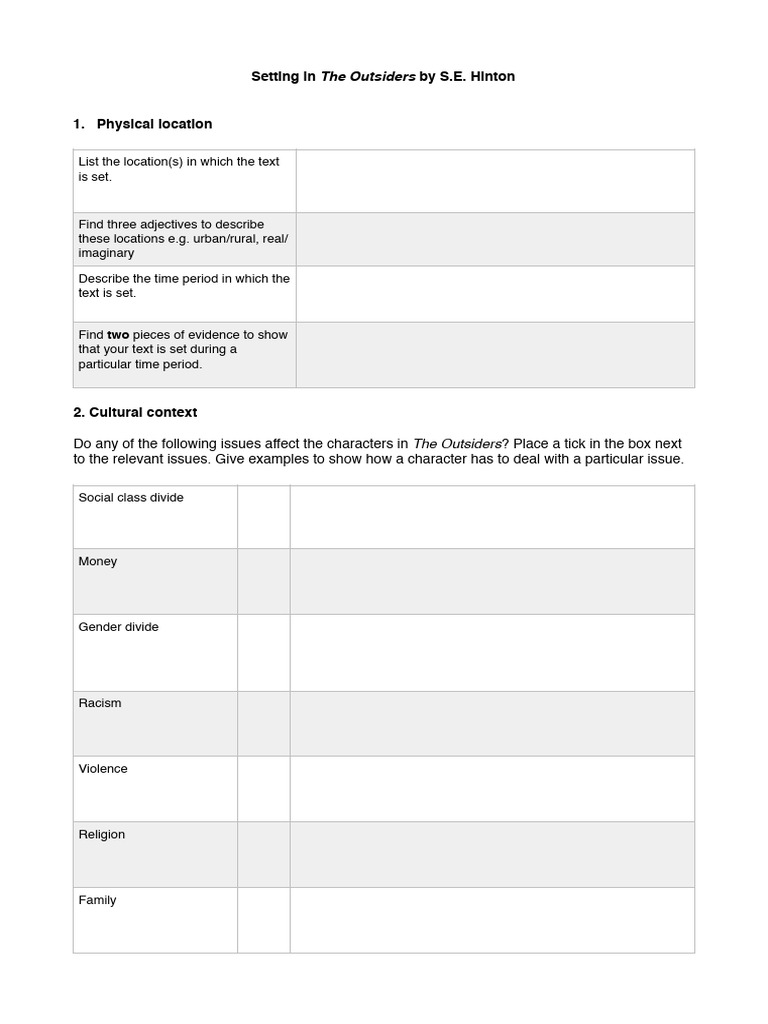The setting of “The Outsiders,” a critically acclaimed novel by S.E. Hinton, serves as a pivotal backdrop that intricately weaves together the characters’ experiences and the overarching themes of class struggle, identity, and belonging. Set in the 1960s in a small American town, the story unfolds primarily in two neighborhoods: the affluent South Side and the impoverished East Side. This dichotomy not only shapes the characters’ interactions but also encapsulates the broader societal issues prevalent during that era. Understanding this setting is essential to grasping the emotional depth and poignancy of the narrative.
The geographical division between the Greasers and the Socs serves as a physical representation of social stratification. The Greasers, typically hailing from lower socioeconomic backgrounds, reside on the East Side. This area is characterized by dilapidated houses, urban decay, and an atmosphere laden with tension. In contrast, the Socs, the wealthier group, represent a certain unattainable ideal, living on the South Side among pristine homes, pristine lawns, and a lifestyle marked by privilege and leisure. This stark juxtaposition is not mere coincidence; it reflects a deeper commentary on the American Dream, exposing the harsh realities that lurk behind the façade of affluence.
One can argue that the setting functions almost as a character within the narrative. It shapes the conflicts the characters face and is intrinsic to their identities. Each scene is steeped in the pervasive mood of the time, echoing the struggles faced by the youth caught in the gears of societal expectations. The East Side, in particular, is rife with hopelessness reflecting the lives of the Greasers, who, despite their bravado, often feel trapped by their circumstances.
Consider the locations where pivotal scenes play out—the vacant lot, the rumble, and the drive-in movie theatre. Each of these places resonates with meaning. The vacant lot, a battleground for the Greasers, symbolizes their defiance and camaraderie, where friendships are forged and losses mourned. This seemingly ordinary space becomes a sacred ground for their struggles, embodying the essence of their shared experiences.
The drive-in theatre, on the other hand, serves as a fleeting escape from the harsh realities of life. For the Greasers, it epitomizes a moment of joy and normalcy. This location sets the stage for pivotal moments of connection, particularly between Ponyboy and Cherry Valance, allowing for glimpses of understanding that transcend their social divides. At the same time, it illustrates the complexities of their relationships, exploring how societal divides complicate genuine connections.
Nighttime is another crucial aspect of the novel’s setting. Darkness offers a shield for the Greasers, allowing them to operate in a world where they feel most at home. The night becomes a sanctuary, a time when they can defy the norms that society imposes on them. Conversely, it also symbolizes lurking dangers and the omnipresent threat of violence, particularly when the tensions between the Greasers and the Socs inevitably escalate. This constant flux between safety and peril reflects the instability inherent in their lives.
Hinton employs vivid imagery to reinforce the distinct atmospheres of the two neighborhoods. The greyness of the East Side, contrasted with the vibrant colors of the South Side, accentuates the disparities in their lives. This visual distinction is not merely aesthetic. It serves as an allegory for the emotional landscapes the characters traverse. The Greasers, often vilified by society, find solace in their brotherhood amidst a bleak reality, forging relationships that are as vital as the air they breathe, reaffirming the theme of loyalty.
The societal and cultural dynamics at play within this setting also highlight the era’s youth culture. The 1960s was a time of great social upheaval, marked by various movements advocating for civil rights, gender equality, and a reevaluation of societal norms. These undercurrents of change complement the narrative’s exploration of identity and belonging. As the Greasers navigate their turbulent lives, they grapple with their roles in a society that often overlooks their struggles. The setting thus becomes a microcosm of a larger societal landscape, where issues of class, race, and identity perpetually collide.
The dialogue within the novel further enriches the portrayal of its setting. The vernacular speech, riddled with colloquial phrases and idioms, captures the essence of the working-class youth during this period. It connects readers to the authentic lived experiences of the characters, making their challenges and triumphs all the more relatable. By grounding the characters in a specific milieu, the narrative transcends the confines of fiction, resonating with the emotional truths of adolescence and the desire for acceptance.
In conclusion, the setting of “The Outsiders” is not merely a backdrop but an integral component of the narrative. Each location, atmosphere, and temporal element enriches the story, offering insights into the characters’ struggles, identities, and the sociocultural forces that shape their lives. The stark contrast between the Greasers and the Socs, coupled with the vivid portrayals of their environments, allows for a profound exploration of themes that resonate well beyond the confines of Hinton’s narrative. It prompts readers to reflect on their societal landscapes, recognizing the timeless quest for belonging in a world often defined by divisions. In this way, “The Outsiders” continues to captivate and inspire, as it holds a mirror to the complexities of youth and the relentless pursuit of understanding in an enigmatic world.
